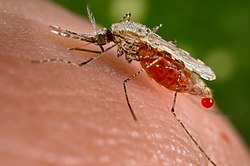Hematophagy


Hematophagy (sometimes spelled haematophagy or hematophagia) is the practice by certain
Mechanism and evolution
Hematophagous animals have mouth parts and chemical agents for penetrating vascular structures in the skin of hosts, mostly of mammals, birds, and fish. This type of feeding is known as phlebotomy (from the Greek words, phleps "vein" and tomos "cutting").
Once phlebotomy is performed (in most insects by a specialized fine hollow "needle", the proboscis, which perforates skin and capillaries; in bats by sharp incisor teeth that act as a razor to cut the skin), blood is acquired either by sucking action directly from the veins or capillaries, from a pool of escaped blood, or by lapping (again, in bats). To overcome natural hemostasis (blood coagulation), vasoconstriction, inflammation, and pain sensation in the host, hematophagous animals have evolved chemical solutions, in their saliva for instance, that they pre-inject—and anesthesia and capillary dilation have evolved in some hematophagous species. Scientists have developed anticoagulant medicines from studying substances in the saliva of several hematophagous species, such as leeches (hirudin).
Hematophagy is classified as either obligatory or facultative. Obligatory hematophagous animals cannot survive on any other food. Examples include
As a feeding practice, hematophagy has evolved independently in a number of arthropod,
In addition to these biological adaptations that have evolved to help blood-feeding arthropods locate hosts, there is evidence that RNA from host species may also be taken up and have regulatory consequences in blood feeding insects. A study on the yellow fever mosquito Aedes aegypti has shown that human blood microRNA has-miR-21 are taken up during blood feeding and transported into the fat body tissues. Once in the fat body they target and regulate mosquito genes such as vitellogenin, which is a yolk protein used for egg production.[6]
Medical importance
The phlebotomic action opens a channel for contamination of the host species with
Insects and
.Hematophagous organisms have been used by physicians for beneficial purposes (
Human hematophagy
Many human societies also drink blood or use it to manufacture foodstuffs and delicacies. Cow blood mixed with
See also
- Chupacabra
- Consumer-resource systems
- Natural reservoir
- Tick-borne disease
- Transmission (medicine)
- Zoonosis
References
- S2CID 25520447.
- OCLC 61354292.
- ^ Mattingly PF (1965). Taylor AE (ed.). "The evolution of parasite-arthropod vector systems". Evolution of Parasites. Symposium of the British Society for Parasitology (3rd), London, November 6, 1964. Oxford: Blackwell Scientific Publications.: 29–45.
- PMID 30846726.
- ISSN 1570-7458.
- PMID 34244602.
- S2CID 2547258.
Further reading
- Scharfetter C, Hagenbuchner K (1967). "Blutdurst als Symptom. Ein seltsamer Fall von Bluttrinken". Psychiatr Neurol. 154 (5). Basel: 288–310. .
- Ciprandi A, Horn F, Termignoni C (2003). "Saliva of hematophagous animals: source of new anticoagulants" (PDF). Rev. Bras. Hematol. Hemoter. 25 (4): 250–262.
- Markwardt F (October 2002). "Hirudin as alternative anticoagulant--a historical review". Seminars in Thrombosis and Hemostasis. 28 (5): 405–14. S2CID 23103375.
- Ribeiro JM (September 1995). "Blood-feeding arthropods: live syringes or invertebrate pharmacologists?". Infectious Agents and Disease. 4 (3): 143–52. PMID 8548192.
